
- Subject:
- Biology
- Material Type:
- Unit of Study
- Provider:
- Rice University
- Provider Set:
- OpenStax College

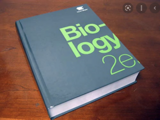
Biology is designed for multi-semester biology courses for science majors. It is grounded on an evolutionary basis and includes exciting features that highlight careers in the biological sciences and everyday applications of the concepts at hand. To meet the needs of today’s instructors and students, some content has been strategically condensed while maintaining the overall scope and coverage of traditional texts for this course. Instructors can customize the book, adapting it to the approach that works best in their classroom. Biology also includes an innovative art program that incorporates critical thinking and clicker questions to help students understand—and apply—key concepts.


By the end of this section, you will be able to do the following:
Identify the shared characteristics of the natural sciences
Summarize the steps of the scientific method
Compare inductive reasoning with deductive reasoning
Describe the goals of basic science and applied science

By the end of this section, you will be able to do the following:
Identify and describe the properties of life
Describe the levels of organization among living things
Recognize and interpret a phylogenetic tree
List examples of different subdisciplines in biology
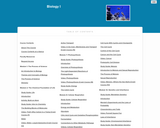
An introduction to biology intended for non-science majors. Focus areas include chemical foundations, cell structure and division, genetics, and evolution.
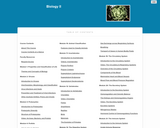
This template course was developed from generally available open educational resources (OER) in use at multiple institutions, drawing mostly from a primary work published by OpenStax College Concepts of Biology, but also including additional open works from various sources as noted in attributions on each page of materials.

This material is labwork meant to be used in conjunction with the Candela "Biology II" course.

This 8-minute video lesson presents an overview of types of immune responses. It looks at the difference between innate and adaptive immunity and the differences between humoral adaptive immunity and cell-mediated adaptive immunity. [Biology playlist: Lesson 52 of 71].

Module 1: Introduction to Biology
The Characteristics of Life
Prokaryotes and Eukaryotes
Taxonomy
The Study of Biology
Module 2: Chemistry of Life
Atoms and Elements
Atomic Bonds
Functional Groups
The pH Scale
Chemical Reactions
Thermodynamics
Assignment: Biological Astronaut
Module 3: Important Biological Macromolecules
Proteins
Lipids
Carbohydrates
Nucleic Acids
Comparing Biological Macromolecules
Assignment: Nutritionist for a Day
Module 4: Cellular Structure
Microscopy
Organelles
The Cytoskeleton
The Cell Surface
Assignment: Cell Builder
Module 5: Cell Membranes
Structure of the Membrane
Kinds of Transport
Endocytosis and Exocytosis
Assignment: Membranes Alive!
Module 6: Metabolic Pathways
Redox Reactions
Photosynthesis
Cellular Respiration
Fermentation
Assignment: Observing Energy Transactions
Module 7: Cell Communication
Signaling Molecules and Cellular Receptors
Propagation of the Signal
Response to the Signal
Signaling in Single-Celled Organisms
Module 8: Cell Division
Chromosomes and DNA Packaging
The Cell Cycle
Cell Cycle Checkpoints
Meiosis
Genetic Diversity
Errors in Chromosome Number
Assignment: Mitosis and Meiosis Internet Quests
Module 9: DNA Structure and Replication
Storing Genetic Information
DNA Base Pairs and Replication
DNA Mutations
Assignment: Which Has More DNA?
Module 10: DNA Transcription and Translation
Transcription
Translation
Prokaryotic Transcription and Translation
The Central Dogma
Module 11: Gene Expression
Regulation of Gene Expression
Prokaryotic Gene Regulation
Eukaryotic Gene Regulation
Assignment: How Mutations Work
Module 12: Trait Inheritance
The Father of Genetics
Beyond Dominance and Recessiveness
Heredity and Disease
Genetics and the Environment
Assignment: Dragon Genetics
Module 13: Theory of Evolution
Charles Darwin
Evidence for Evolution
Mutations and Evolution
Phylogenetic Trees
Module 14: Modern Biology
Key Technologies
Biotechnology Applications
Risks and Benefits of Genomic Science
Assignment: When Jabberjays Attack!

Module 1: Introduction to Biology
Characteristics of Life
Prokaryotes and Eukaryotes
Taxonomy
The Study of Biology
Module 2: Viruses
Viral Evolution, Morphology, and Classification
Virus Infections and Hosts
Prevention and Treatment of Viral Infections
Prions and Viroids
Module 3: History of Life
Evolution
Speciation
The Evolution of Populations
Phylogenies and the History of Life
Module 4: Prokaryotes
Prokaryotic Diversity
The Structure of Prokaryotes
Prokaryotic Metabolism
Bacterial Diseases in Humans
Beneficial Prokaryotes
Module 5: Protists
Characteristics of Protists
Groups of Protists
Ecology of Protists
Module 6: Fungi
Characteristics of Fungi
Classifications of Fungi
Ecology of Fungi
Fungal Parasites and Pathogens
Module 7: Plant Diversity
Seedless Plants
Seed Plants
Module 8: Plant Structure and Function
Plant Structures
Transport of Water and Solutes in Plants
Plant Sensory Systems and Responses
Plant Growth
Plant Nutrition
Module 9: Plant Reproduction
Reproductive Development and Structure
Asexual Reproduction in Plants
Sexual Reproduction in Plants
Module 10: Animal Diversity
Evolutionary History of the Animal Kingdom
Animal Phylogeny
Animal Form and Function
Animal Primary Tissues
Animal Reproduction
Homeostasis
Module 11: Invertebrates
Phylum Porifera
Phylum Cnidaria
Superphylum Lophotrochozoa
Superphylum Ecdysozoa
Superphylum Deuterostomia
Module 12: Vertebrates
Chordates
Fishes
Amphibians
Amniotes
Reptiles
Birds
Mammals
Module 13: Overview of Body Systems
Integration of Systems
Control Systems
Cell Maintenance Systems
Support Systems
Module 14: The Nervous System
Components of the Nervous System
Neuron Communication
The Central Nervous System
The Peripheral Nervous System
Nervous System Disorders
Module 15: The Endocrine System
Types of Hormones
How Hormones Work
Regulation of Body Processes
Endocrine Glands
Module 16: The Reproductive System
Reproduction Methods
Human Reproductive Anatomy
Hormonal Control of Human Reproduction
Fertilization
Early Embryonic Development
Human Pregnancy and Birth
Module 17: Sensory Systems
The Senses
Somatosensation
Taste and Smell
Hearing and Vestibular Sensation
Vision
Module 18: The Circulatory System
The Circulatory System
Structure and Function of Blood
The Mammalian Heart
Blood Flow and Blood Pressure Regulation
Module 19: The Respiratory System
Systems of Gas Exchange
Gas Exchange across Respiratory Surfaces
Breathing
Transport of Gases in Human Bodily Fluids
Module 20: The Immune System
The Innate Immune Response
The Adaptive Immune Response
Antibodies
Module 21: The Digestive System
Digestive Systems
Nutrition and Energy Production
Digestive System Processes and Regulation
Module 22: The Excretory System
Osmoregulation and Osmotic Balance
Kidneys and Osmoregulatory Organs
Excretion Systems
Module 23: The Musculoskeletal System
Skeletal Systems
Bones
Joints and Skeletal Movement
Muscle Contraction and Locomotion
Module 24: The Integumentary System
Structure and Function of Skin
Accessory Structures of the Skin
Functions of the Integumentary System
Diseases, Disorders, and Injuries of the Integumentary System
Module 25: Ecology of Living Things
The Scope of Ecology
Biotic and Abiotic Factors
Biomes
Population Ecology
Community Ecology
Module 26: Ecology and the Environment
Energy in the Environment
Biogeochemical Cycles
Climate Change
Conservation Biology and Biodiversity

Includes the study of the gross and microscopic structure of the systems of the human body with special emphasis on the relationship between structure and function. Integrates anatomy and physiology of cells, tissues, organs, the systems of the human body, and mechanisms responsible for homeostasis.
Also available here:https://courses.lumenlearning.com/atd-herkimer-biologyofaging/
Table of Contents:
I. Chapter 1: Introduction to Human Aging
II. Chapter 2: Theories of Aging
III. Chapter 3: Cellular Aging
IV. Chapter 4: The Integumentary System
V. Chapter 5: Bone Tissue and The Skeletal System
VI. Chapter 6: The Skeletal Muscle System
VII. Chapter 7: The Nervous System
VIII. Chapter 8: The Special Senses
IX. Chapter 9: The Circulatory System
X. Chapter 10: The Immune System
XI. Chapter 11: The Respiratory System
XII. Chapter 12: The Digestive System
XIII. Chapter 13: The Urinary System
XIV. Chapter 14: The Reproductive System
XV. Chapter 15: The Endocrine System
XVI. Course Information
XVII. Term Research Project

This course will introduce the student to the major concepts of biotechnology. The student will discuss genetic engineering of plants and animals and the current major medical, environmental, and agricultural applications of each. There are also a variety of topics that this course will cover after ranging from nanobiotechnology to environmental biotechnology. Upon successful completion of this course, the student will be able to: identify and describe the fields of biotechnology; compare and contrast forward and reverse genetics and the way they influence biodiversity; compare and contrast systemic studies of the genome, transcriptome, and proteome; explain how genome projects are performed, and discuss the completion and the information processing in these projects; describe and explain the principles of existing gene therapies; design strategies that support genetic counseling; explain and analyze DNA fingerprints, and compare DNA fingerprints to non-DNA biometrics; describe and compare bioremediation technologies in air, water, and soil; design strategies for generating genetically modified organisms, and discuss ethical concerns; discuss emerging fields in biotechnology. (Biology 403)

In this course, you will learn the basics of plant biology. The student will begin with plant anatomy, learning the names and functions of all of the parts of a plant, then move on to plant physiology, where you will learn about photosynthesis, growth, and reproduction. Next, the student will study plant evolution according to the fossil record and examine the diversity of plant life in existence today and how that diversity impacts global ecology. Upon successful completion of this course, the student will be able to: identify and describe the functions of the different cells, tissues, and organs that make up a plant; describe the major life processes in plants (photosynthesis, respiration, transpiration, growth and development, and reproduction) at the tissue, organ, cellular, and molecular level; explain the history and evolution of plants on earth; discuss plant diversity and identify the major characteristics of plant phylogenetic divisions; explain how plants fit into the global ecological system and why they are essential for life on earth. (Biology 306)

This course will cover the origins of cancer and the genetic and cellular basis for cancer. It will examine the factors that have been implicated in triggering cancers; the intercellular interactions involved in cancer proliferation; current treatments for cancer and how these are designed; and future research and treatment directions for cancer therapy. Upon successful completion of this course, the student will be able to: explain how the perception of cancer and theories of its causes have changed throughout history because of important discoveries made by scientists, researchers, and physicians; summarize the importance of understanding cell biology in the study of cancer, its causes, it progression, and its treatment; outline the transcription and translation processes used to convert DNA into proteins and what changes occur that convert proto-oncogenes into oncogenes and lead to unchecked cell growth and cancer; compare and contrast the mechanisms by which activation of oncogenes, loss of tumor suppressors, loss of cell cycle checkpoints, and development of faulty DNA repair lead to cancer; describe the various cancer prevention mechanisms including risk assessment, screening, and lifestyle and environmental modification; list the past, current, and future cancer treatments and the mechanism by which these target cancer causing cells. (Biology 404)
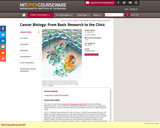
Seminar covering topics of current interest in biology. Includes reading and analysis of research papers and student presentations. Contact Biology Education Office for topics. This course is one of many Advanced Undergraduate Seminars offered by the Biology Department at MIT. These seminars are tailored for students with an interest in using primary research literature to discuss and learn about current biological research in a highly interactive setting. In 1971, President Nixon declared the "War on Cancer," but after three decades the war is still raging. How much progress have we made toward winning the war and what are we doing to improve the fight? Understanding the molecular and cellular events involved in tumor formation, progression, and metastasis is crucial to the development of innovative therapy for cancer patients. Insights into these processes have been gleaned through basic research using biochemical, molecular, and genetic analyses in yeast, C. elegans, mice, and cell culture models. We will explore the laboratory tools and techniques used to perform cancer research, major discoveries in cancer biology, and the medical implications of these breakthroughs. A focus of the class will be critical analysis of the primary literature to foster understanding of the strengths and limitations of various approaches to cancer research. Special attention will be made to the clinical implications of cancer research performed in model organisms and the prospects for ending the battle with this devastating disease.
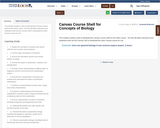
This module contains a link to download the Canvas Course shell for this entire course. The link will allow instructors from institutions that use the Canvas LMS to download the entire Canvas course for use.

This course will present the student with a detailed overview of a cell's main components and functions. The course is roughly organized into four major areas: the cell membrane, cell nucleus, cell cycle, and cell interior. The student will approach most of these topics straightforwardly, from a molecular and structural point of view. Upon completion of this course, the student will be able to: explain what a eukaryotic cell is, identify the components of the cell, and describe how a cell functions; explain how cell membranes are formed; identify the general mechanisms of transport across cell membranes; list the different ways in which cells communicate with one another--specifically, via signaling pathways; define what the extracellular matrix is composed of in different cells and how the extracellular matrix is involved in forming structures in specific tissues; list the components of the cell's cytoskeleton and explain how the cytoskeleton is formed and how it directs cell movements; explain the fundamentals of gene expression and describe how gene expression is regulated at the protein level; define and explain the major cellular events involved in mitosis and cytokinesis; identify the major cellular events that occur during meiosis; describe the eukaryotic cell cycle and identify the events that need to occur during each phase of the cell cycle; identify all of the major organelles in eukaryotic cells and their respective major functions. (Biology 301)
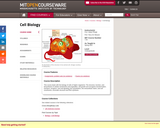
Biology of cells of higher organisms: structure, function, and biosynthesis of cellular membranes and organelles; cell growth and oncogenic transformation; transport, receptors and cell signaling; the cytoskeleton, the extracellular matrix, and cell movements; chromatin structure and RNA synthesis.